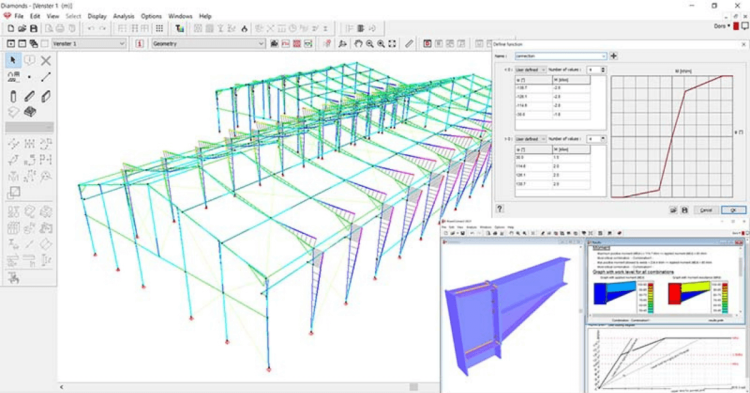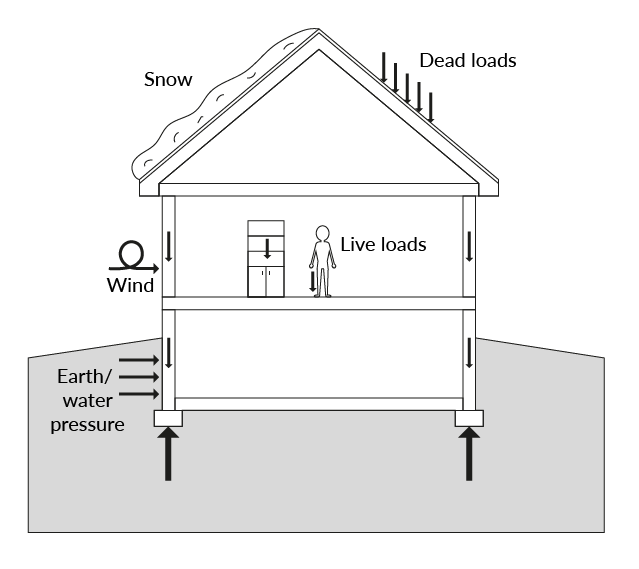
Structural design is the process of creating a safe and functional structure under any load that it may experience. During this process, the structural engineer will determine the structure's stability, strength, and stiffness (rigidity). The basic objective in structural design and analysis is to produce a structure capable of resisting all applied loads without failure during its intended life.
There are mainly 5 essential steps to be followed for the design of any structure. (1) modelling, (2) load analysis, (3) structural analysis, (4) structural design and (5) detailing.
1. Modelling
The first step is to model the structure’s mechanical skeleton, including its foundations, columns, beams, frames, trusses, and other elements. The start point is the architectural model. An architectural model shows what the structure will look like in reality, but it is not suitable for calculations due to the high level of detailing. The architectural model needs to be stripped until only the load-bearing structure remains. The load-bearing structure will transfer the applied loads to the ground.
Translating the load-bearing structure to a model ready for calculations is called schematization or creating the wireframe model, the mechanical model, or the plan of the model.
Schematization is a very important step: it is essential that that the mechanical model can anticipate loads since it would be the basis for the whole process.

The most used structural elements which can be included in the structural model are:
• Beams;
• Columns;
• Struts and ties;
• Slabs;
• Shear walls;
• Membranes.
Furthermore, modelling involves determining the structure’s material, whether it would be “structural steel”, “reinforced or prestressed concrete”, “timber”, or any material. The choice depends mostly upon the economy and safety of a structure. A lot of structure consists of both steel, concrete, and timber elements.
Modelling also involves assuming dimensions for each element which is the basis for self-weight computation for the load analysis. Estimating the member size includes what should be the element width, the depth or the thickness. Rules of thumb can be used for the choice of the initial dimensions.
Another relevant aspect in the modelling consists of defining the internal and external boundary conditions of the members that make up the structure.
2. Load analysis
Next, the structural engineer must identify all possible loads that the structure may experience during its lifetime. Examples of loads on structures are:
• Dead loads, meaning the self-weight of the structure
• Live loads: occupancy of people in buildings, moving equipment, and the movement of cars on bridges;
• Wind loads: any horizontal, uplift or shear pressures or forces that the wind exerts on a building;
• Snow loads: only applicable for structures expected to receive snowfall;
• Earthquake loads: when the structure is in a seismic region;
• Earth pressure: to be applied for tunnels, retaining walls, cellars;
• Water and ice: for some structures such as bridges, offshore platforms, and coastal structures;
• Thermal loads: Unequal heating or cooling of parts of the structure create high stresses;
• Dynamic loads: for example, induced by machinery.
So, depending on where your structure is, you must consider the various kinds of loads. The values of these loads can be identified using appropriate structural design codes and references.
In real life, different loads act simultaneously with the structure. The combination of the various loads should be evaluated. For instance, a simultaneous action between dead load (weight of the structure) and live load (use of the building by people) can be a load combination. But also, dead loads and wind loads can be a combination. Finding which is the worst load combination for your structure is a part of the loads analysis process. Usually, structural engineering software will automatically create a set with all possible loads combinations.

3. Structural analysis
In this step, we perform the analysis on the structural members. The goal is to investigate how the structural model behaves with the different load combinations made. The analysis of a whole structure is also known as the global analysis.
The results of the analysis include the internal forces diagrams (shear, bending moment, normal, torsion and stresses), reactions, deformations/ deflections produced by the different load combinations.
For simple structures, like a single beam or column, this analysis can be done by hand. However, for 2D or 3D structures, the analysis requires many detailed computations, mostly in matrices, in which errors are quickly made in case of hand calculations. Computer Structural Design Software has now replaced manual computation. Most structural engineering software, such as BuildSoft’s Diamonds, use FEA – Finite Element Analysis to solve the complex equilibrium equations. A great structural analysis software should be fast and user-friendly to make life easier for beginners and advanced users.
4. Structural design
Structural design is, perhaps, the most crucial step in the process. It involves dimensioning the different parts of the building based on the analysis results. Structural design is material related.
The initially estimated dimensions are verified for the design requirements on the field of the stability, strength and stiffness (rigidity/deflection). These requirements can be found in the design code.
If these design requirements are satisfied, the chosen dimensions are ok. One can consider playing with the element sizes to achieve a more economical design.
If the design requirements are not satisfied, then the engineer should repeat all these steps. The initial element dimensions should be increased, and we loop again through the structure analysis and structural design verifications. This is repeated until the design requirements are met.
The result of the structural design represents the dimensions of each element in the model, complying with the design requirements, together with material related details, such as the required area of reinforcement to be provided for concrete elements.
Many countries have their structural design codes, codes of practice or technical documents. It is necessary for a structural designer to become familiar with local requirements and recommendations concerning correct practice.
5. Detailing
Once the global analysis and design are finished, the structural engineer can start detailing. Structural detailing consists of 2 parts:
1. Where should the details be placed and where should structural connections and overlaps be made? For example, beam or column splices. For other details like beam-column or column base connections, the placement cannot be discussed.
2. The specifications of reinforcement, bolts, and welds, that is the number of reinforcement bars, bolt grade, number of bolts, weld throat thickness, end plates etc.
The detailing goes hand in hand with the ductility of the structures. In the case of concrete, for example: If we provide the reinforcement in a balanced way in beam and columns, we can increase the ductility of a structure.
If we plan steel connections strategically, the costs can be highly reduced. The overlap between 2 beam parts should not be at the centre of the beam but rather near the column edges, where the bending moment is 0 (hinged joint). That way, only a shear connection is required, which is easier to construct and more cost-effective.

The importance of structural design and analysis software
To become great at structural design and analysis, it is recommended to learn and improve your skills. As such, do not stop at this article. Follow up on your learning needs and then start working with a software. For example, you can choose our free courses on concrete & steel with Diamonds or watch our YouTube videos to enhance your knowledge.
Please see the product page if you want to find out more about Diamonds, our core structural analysis software. You can also try the free trial option and use our Diamonds software for 30 days fully functional.
Drop us a message if you have any questions or check our support options. We would be happy to help.
